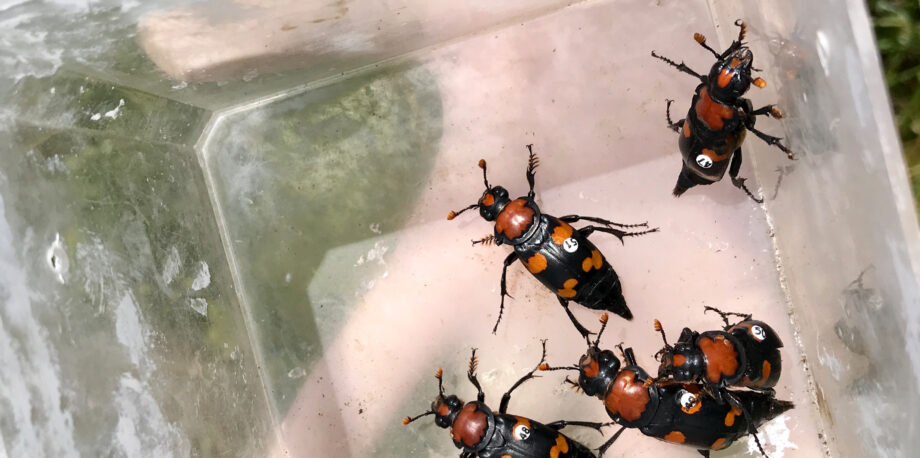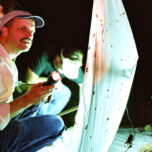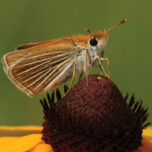May 28, 2020 — Bob Merz took it for granted that the unassuming American burying beetle would be in Missouri somewhere, under the soil surface, doing its job of slowly nibbling away the waste of the world.
Merz, director of the Center for American Burying Beetle Conservation at the Saint Louis Zoo, knew the beetle had been seen in neighboring states and even bet a coworker that they’d find the bright orange-spotted insects after undertaking a survey of them all over Missouri starting in 2001. He lost that bet.
“We looked for years,” he says. “There were no beetles found.”
As a lifelong insect observer, Merz found that tremendously unsettling. “To lose a whole species and not even notice it is kind of startling to me,” he says. “It was a personal wake-up call that things are off.”
The American burying beetle is not the only invertebrate quietly slipping away. Stories of an “insect apocalypse” came to a head in 2018 as scientists sent out the alarm on the dramatic loss of populations around the world.

Bob Merz leads Saint Louis Zoo efforts to restore American burying beetle populations in the Upper Midwest. Photo courtesy of the St. Louis Zoo
But there’s another story that the American burying beetle is a part of. It’s the less-told but equally important story of bringing uncharismatic minifauna back from the brink through cooperation among sometimes-opposing groups: private landowners, public officials and conservation activists.
Missing Beetles
The American burying beetle is a vital part of soil ecosystems, breaking down dead things and allowing the nutrients they hold to move back into the living world. It was once found in at least 35 states, but in 1989 it was declared endangered due to land use change and other factors. The remaining populations are found predominantly in the Midwest, including states bordering Missouri. Southwestern Missouri shares similar prairie habitat to these states, so the Saint Louis Zoo began breeding the insect and reintroducing it to that region in 2012.
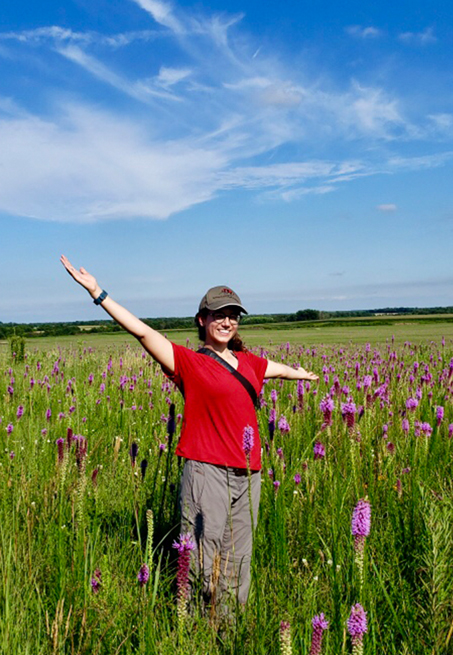
Saint Louis Zoo manager of invertebrates Kayla Garcia is a key player in efforts to reintroduce American burying beetles in Missouri. Photo courtesy of the Saint Louis Zoo
As zoological manager of invertebrates with the Saint Louis Zoo, Kayla Garcia oversees the breeding of the beetles. At the zoo, the beetles are paired up, then given a dead quail. The female lays eggs on the quail and once the grubs hatch, the parents work together to feed the babies, a rare action in the insect world, notes Garcia. After grubs mature, zoo staff collect the adult beetles to either be used in breeding or released at various sites around southwestern Missouri.
Local officers from the Missouri Department of Conservation talk to local landowners to give them a heads-up on the beetle reintroduction. The presence of an endangered species on private land can activate a law that limits how that landowner can use the land. So the Saint Louis Zoo, working with the U.S. Fish and Wildlife Service, designated this population of the beetle as a nonessential experimental population, or NEP. That means local landowners can still farm even if the beetle is found on their property.
Achieving NEP designation and having local conservation officers reach out was a great way to get landowners to cooperate with the introduction, says Merz. Some property owners, understanding the beetle’s value to the ecosystem, even asked the zoo to survey their land to see if the beetles have set up shop.
The zoo has been releasing roughly 200–600 beetles every year since 2012. Last year’s survey yielded 39 beetles, including 29 offspring of the zoo-bred beetles.
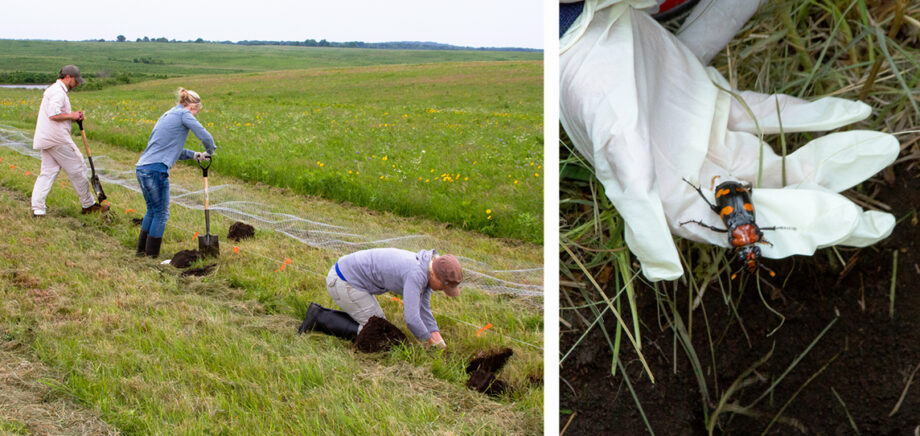
Workers (left) release Saint Louis Zoo–bred American burying beetles (right) across the Wah’ Kon-Tah Prairie in southwestern Missouri. Photos courtesy of the Saint Louis Zoo
The hope is that “they will be able to reestablish themselves on these lands without our active intervention and hopefully expand where they’re found,” Garcia says.
Multilayered Benefits
The American burying beetle is one of the few insect reintroduction projects around the country. Other notable initiatives include bringing back the Karner blue butterfly to parts of the Upper Midwest and reintroducing the Puritan tiger beetle in Connecticut. More common than reintroduction efforts are incentive or education programs to encourage landowners to grow plants that support pollinators.
That type of project is vital in Iowa, where some 98% of land is privately owned, according to Peter Berthelsen, president of Conservation Blueprint and partnership director of The Bee & Butterfly Habitat Fund.
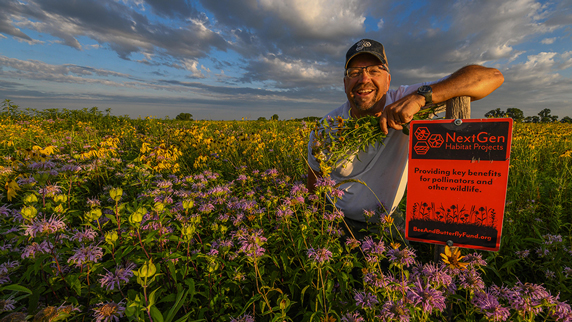
Conservation Blueprint president Peter Berthelsen helps landowners grow plants that not only support insect diversity, but also provide other ecosystem benefits. Photo courtesy of Conservation Blueprint
“If you want to have a significant impact on the environment, you have to do that working with agriculture and private landowners,” Berthelsen says. “That’s where the rubber hits the road.”
Berthelsen’s organizations supply private landowners with seed packets for plants that support pollinators. In a project with the Iowa Soybean Association (ISA) and agribusiness Syngenta, Berthelsen is providing farmers packets to grow plants that support the endangered rusty patched bumble bee. Berthelsen says that Syngenta covers the cost of the seeds, and the ISA reaches out to its members to find places to plant the seeds.
Berthelsen says farmers can plant the seeds near streams, waterways or spare fields. “If you want to have the most significant environmental benefits possible, you need to work very collaboratively, trying to address as many issues as you can,” he says. If a landowner plants wildflowers next to a stream, it’s not only helping pollinators, but also prevents erosion and nutrient runoff. “It’s multilayered benefits.”
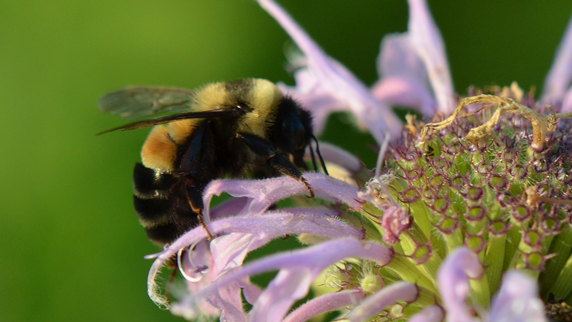
Conservation organizations, agribusiness and farmers are working together to help the endangered rusty patched bumble bee rebound in Iowa. Photo courtesy of USFWS Midwest from Wikimedia, licensed under CC BY 2.0
Through the Bee and Butterfly Habitat Fund, Berthelsen says farmers receive free seed mixtures for wildflower plantings 2 acres (0.8 hectares) or larger. In addition, he provides guidance on how to prepare, plant and manage the site. Seed selection is based on the needs of the farmer and site constraints.
The idea is to think about habitat with biodiversity in mind, says Berthelsen. Instead of looking at a project to just benefit monarchs or bumble bees, habitat projects can be designed that address the whole gamut of soil health, water quality, pollinator needs, grassland songbirds, pheasants and quail, “all of those things can and should be part of the recipe for when a seed mixture is designed and created and we work with a landowner,” he adds.
“There’s room for conservation on every farm and ranch on the country, and those are the opportunities where we can have significant benefits from the environment.”
And, according to Merz, it’s not difficult for local landowners to understand and value biodiversity: They realize that insects are canaries in the coal mine when it comes to alerting people to problems that need attention. One of the landowners near the burying beetle survey sites, for example, mentioned that he used to hunt gamebirds like pheasant on his land, but those birds, like the beetles, have disappeared.
“It tells me that something is wrong with the ecosystem, and I think most people get that,” says Merz.
Related Posts
Ensia shares solutions-focused stories free of charge through our online magazine and partner media. That means audiences around the world have ready access to stories that can — and do — help them shape a better future. If you value our work, please show your support today.
Yes, I'll support Ensia!